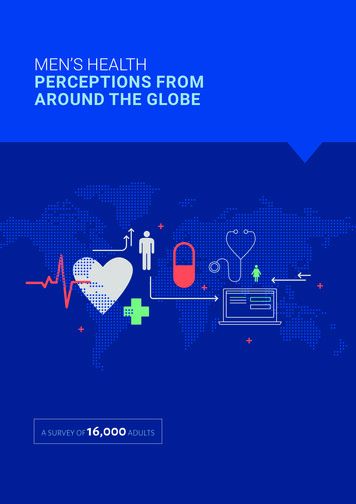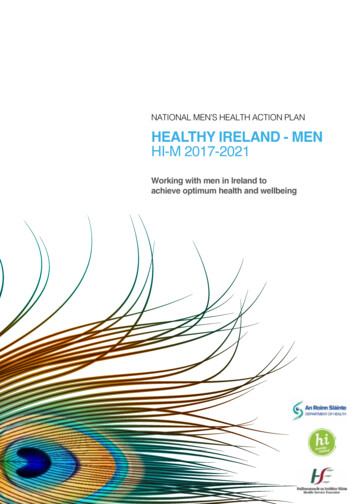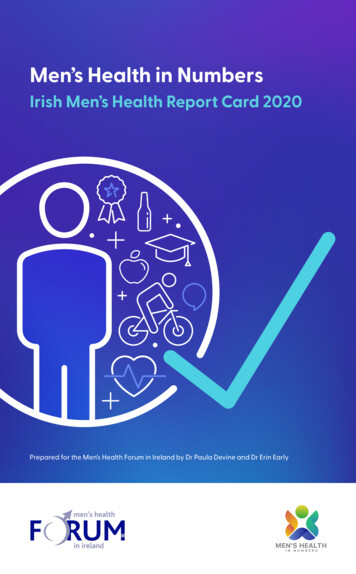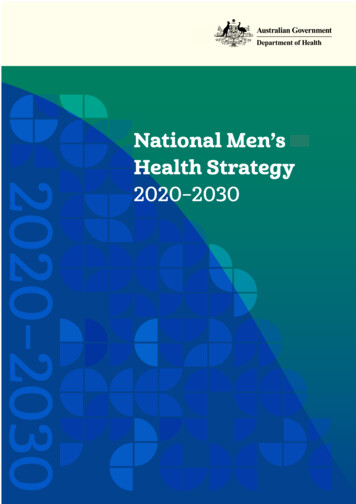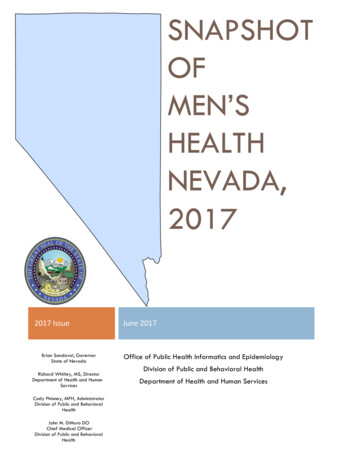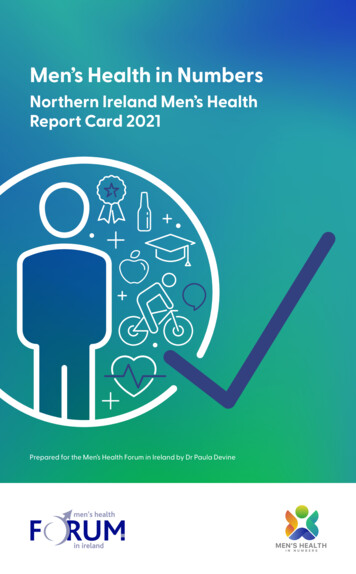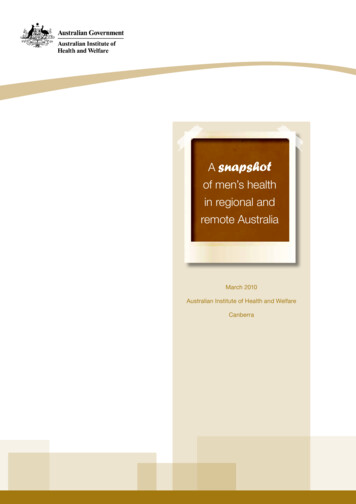
Transcription
Aof men’s healthin regional andremote AustraliaMarch 2010Australian Institute of Health and WelfareCanberra
The Australian Institute of Health and Welfare is Australia’s nationalhealth and welfare statistics and information agency. The Institute’s mission isbetter information and statistics for better health and wellbeing. Australian Institute of Health and Welfare 2010This work is copyright. Apart from any use as permitted under the Copyright Act 1968, no part maybe reproduced without prior written permission from the Australian Institute of Health and Welfare.Requests and enquiries concerning reproduction and rights should be directed to the Head,Communications, Media and Marketing Unit, Australian Institute of Health and Welfare, GPO Box 570,Canberra ACT 2601.This publication is part of the Australian Institute of Health and Welfare’s Rural health series. Acomplete list of the Institute’s publications is available from the Institute’s website www.aihw.gov.au .ISSN 1448-9775ISBN 978 1 74024 995 9Suggested citationAustralian Institute of Health and Welfare 2010. A snapshot of men’s health in regional and remoteAustralia. Rural health series no. 11. Cat. no. PHE 120. Canberra: AIHW.Australian Institute of Health and WelfareBoard Chair: Hon. Peter Collins, AM, QCDirector: Penny AllbonAny enquiries about or comments on this publication should be directed to:Sally BullockAustralian Institute of Health and WelfareGPO Box 570Canberra ACT 2601Phone: (02) 6244 1008Email: sally.bullock@aihw.gov.auPublished by the Australian Institute of Health and WelfarePrinted by Bluestar Print ACTPlease note that there is the potential for minor revisions of data in this report.Please check the online version at www.aihw.gov.au for any amendments.
ContentsAcknowledgments .ivAbbreviations .vSummary .vi1Introduction . .12Analysis methods .43Men in rural Australia .6Characteristics and demographics . .6Socioeconomic status and the rural–urban health gap .94The health of men in rural Australia . .12Health determinants .12Self-assessed health status .14Health conditions .15Cancer .15Mental disorders . 17Changes in health status over time . 175Men in the general practice setting . .19General practice data . .19Why do men visit a GP? . .20What health problems do GPs manage for men?.21How are health problems managed?.236Mortality .25What are rural men dying from?.26How much higher are rural death rates?.26How has rural mortality changed over time?.30What health problems contribute to higher rural death rates?.30Life expectancy . .32Marriage and mortality .32Mortality across states/territories .33Appendix A: Data sources and methods .41Appendix B: Detailed tables .49References .54List of tables .57List of figures .58Aof men’s health in regional and remote Australiaiii
AcknowledgmentsThe authors of this report (in alphabetical order) were Sally Bullock, Robert Long and Lisa Thompson.Expert advice and commentary were provided by Mark Cooper-Stanbury, the AIHW Population HealthUnit and AIHW subject area units with expert knowledge in data sources (Cardiovascular Disease,Diabetes and Kidney Unit; Cancer and Screening Unit; Respiratory and Musculoskeletal DiseasesUnit; Indigenous Determinants and Outcomes Unit). The Australian General Practice Statistics andClassification Centre (AGPSCC) provided guidance on the use and interpretation of the Bettering theEvaluation and Care of Health (BEACH) data.Funding for this report was provided by the Office of Rural Health, Australian Government Departmentof Health and Ageing.ivAof men’s health in regional and remote Australia
AbbreviationsALLSAdult Literacy and Life Skills SurveyASGCAustralian Standard Geographical ClassificationASGC RAAustralian Standard Geographical ClassificationRemoteness Areas classificationABSAustralian Bureau of StatisticsBEACHBettering the Evaluation and Care of HealthCAPSCoding Atlas for Pharmaceutical SubstancesCDCensus collection districtCOPDchronic obstructive pulmonary diseaseDSM-IVDiagnostic and Statistical Manual of Mental Disorders, Fourth EditionERPestimated resident populationGPgeneral practitionerIRInner regionalIRSDIndex of Relative Socioeconomic DisadvantageICD-10International Statistical Classification of Diseases, and Related HealthProblems, 10th RevisionICPC-2International Classification of Primary Care—2nd editionMCMajor citiesMVAmotor vehicle accidentNCSCHNational Cancer Statistics Clearing HouseNDSHSNational Drug Strategy Household SurveyNHSNational Health SurveyOECDOrganisation for Economic Co-operation and DevelopmentOROuter regionalRRemoteRARemoteness AreasRFEreason for encounterSEIFASocio-Economic Indexes for AreasSESsocioeconomic statusSSDStatistical SubdivisionVRVery remoteWHOWorld Health OrganizationWMH-CIDI 3.0World Mental Health Composite International Diagnostic Interview—version 3.0Aof men’s health in regional and remote Australiav
SummaryIn late 2008, the Australian Government announced its intention to develop Australia’s first NationalMen’s Health Policy, which will have a focus on a number of groups including men in rural areas.Drawing on several data sources, this report provides a snapshot of the health of men in rural Australiacompared with urban areas.Why rural men?There is a strong relationship between poor health and social and economic disadvantage. Comparedwith urban areas, rural regions of Australia contain a larger proportion of people living in areas ofsocioeconomic disadvantage. This fact, combined with the generally poorer health status of mencompared with women, justifies the specific consideration of rural men in this report.Room for improvement in the health of rural menThis report confirms previous findings that rural men are more likely than their urban counterparts toexperience chronic conditions and health risk factors.In 2004–06, male death rates increased with remoteness. Compared with Major cities, death ratesranged from 8% higher in Inner regional areas to up to 80% higher in Very remote areas.Several areas of health continue to be of particular concern for rural men. Four of these arehighlighted below.Cardiovascular disease and diabetesDeath rates from these diseases increased with remoteness. Cardiovascular diseases wereresponsible for nearly a third of the elevated male death rates outside Major cities.Male death rates from diabetes were 1.3 times as high in Inner regional areas and 3.7 times as high inVery remote areas as compared with Major cities.Alcohol and other drugsMen living outside Major cities were more likely to report daily smoking and risky orhigh-risk alcohol use than their counterparts in Major cities. They were also more likely to haveexperienced a substance use mental disorder throughout their lifetime. The incidence of head andneck cancers and lip cancers, two groups of cancers associated with increased smoking and alcoholconsumption, was also higher outside Major cities.InjuryMale death rates due to injury and poisoning increased with remoteness; rates in Very remote areaswere 3.1 times as high as Major cities. Similarly, men living outside Major cities were 18% more likely toreport a recent injury.Health literacyIn 2006, men living in Inner regional and Outer regional/Remote areas were 22% less likely than men inMajor cities to possess an adequate level of health literacy.viAof men’s health in regional and remote Australia
Introduction1IntroductionBackgroundThe health challenges facing men have recently been highlighted by the Australian Government’sdevelopment of a National Men’s Health Policy (the Policy). The Policy’s aim is to improve the healthof Australian men throughout their lives. It will focus upon reducing the barriers men face in accessinghealth services, improving male-friendly health care, addressing the reluctance that men may feelin seeking treatment and raising awareness of preventable health problems (DoHA 2008). In theseoverarching objectives, attention has been drawn to communities of men in Australia with the poorestlevels of health. Men in regional and remote regions have been recognised as a group with distinct andspecial needs.In most areas of health, men have poorer outcomes than women. This is also true in the rural contextwhere men share a higher burden of disease than women (Begg et al. 2007; AIHW 2007). Whilebiological factors may explain some differences in health outcomes between men and women, thereis a growing awareness of the role played by social determinants of health, such as education, culturalpractices and environmental factors. In particular, cultural norms and values influence the way menthink about their health and seek help for physical and mental problems.This report provides a snapshot of the health status of men in rural Australia. While the findings arefrom a limited number of data sources, they provide a useful starting point to monitor any changes tothe health status of rural men throughout the course of the Policy.Why men?Research has consistently shown a sex differential in morbidity and mortality. The most publicisedstatistic is men’s lower life expectancy—approximately 5 years less than females (AIHW 2008a). Afteradjusting for age, in 2006 the mortality rate for men was approximately 50% higher than for women(731 compared with 493 deaths per 100,000) (AIHW 2008b). In particular, rates of death for men ofworking age (25–64 years) were substantially higher than their female counterparts.In 2003, men experienced more of the disease burden than females for cancers, diabetes,cardiovascular disease, chronic obstructive pulmonary disease (COPD) and injuries (includingsuicide) (Begg et al. 2007). Compared with females, men also experienced a higher burden of healthrisk factors such as misuse of alcohol, and use of tobacco and drugs; occupational exposuresand hazards; physical inactivity; high blood pressure and cholesterol; high body weight and lowconsumption of fruit and vegetables (Begg et al. 2007). In Australia, men are also less likely thanwomen to report their health as good or better (ABS 2006a). Interestingly, this is inconsistent with thepattern observed in similar developed countries where men rate their health as good or better moreoften than women (OECD 2009).Use of appropriate health care services is critical for disease prevention and management, yet thereis a growing awareness that men and women have quite different health seeking behaviours (Smith,Braunack-Mayer & Wittert 2006). In Australia, there are much lower levels of health service use amongmales compared with females (Bayram et al. 2003; DoHA 2005; AIHW & DoHA 2008). While men arenot necessarily less interested in or concerned about their health, they are generally less likely to seeAof men’s health in regional and remote Australia1
themselves as being at risk of illness or injury (Courtenay 2003) and are more likely to dismiss healthsymptoms until they become severe or life-threatening (Galdas, Cheater & Marshall 2005).Social support, especially in times of crisis, is likewise considered important for good health. Researchhas shown that men have smaller social networks, and more limited support, than women, with highlevels of social support associated with positive health practices (Courtenay 2003). It is clear thatsociocultural factors, combined with generally higher prevalence of disease and risk factors thanwomen, support specific research and policy consideration of men as a population group.Why men in rural areas?Over half of Outer regional, Remote, and Very remote residents live in areas of socioeconomicdisadvantage, while the corresponding figure in Major cities is about one quarter. In general, peoplewho are socially and economically disadvantaged have poorer health outcomes and increased healthrisk factors (AIHW 2008a). Aboriginal and Torres Strait Islander people, who comprise a greaterproportion of remote populations, are particularly socioeconomically disadvantaged compared withother Australians.Analysis of deaths during 1998–2000 found that men aged 25–64 years in the most socioeconomicallydisadvantaged group had a mortality rate almost double that of their female counterparts (Furler 2005).Furthermore, there is evidence that the relative disadvantage in the life expectancy of men comparedwith women is greater in the unskilled/manual category than professional workers (Wilkinson 2005).This is particularly relevant to rural areas where a higher proportion of men are employed in primaryproduction compared with urban areas (see Section 3).The higher proportion of socioeconomically disadvantaged people in rural areas, combined with thepoorer health status of men compared with women, highlights a potential double disadvantage formen living in rural areas. Men’s health issues may be compounded by specific barriers accessingservices including long working hours, requirements of seasonal work, discomfort in the waiting roomenvironment, privacy issues centering on others not knowing they have visited a service and a fear ofknowing their true health status (Buckley & Lower 2002). These barriers exist in addition to the generalbarriers to access and availability of health services in more remote areas of Australia.Nonetheless, the focus on men in this publication is not intended to imply that particular health needsdo not also exist for rural women. For example, in 2002–04 all-cause mortality rates for women livingoutside Major cities were between 10–70% higher than their counterparts in Major cities (AIHW 2007).Women living outside Major cities were also more likely to report diabetes, arthritis, asthma and severalhealth risk behaviours such as smoking than their counterparts in Major cities (AIHW 2008c).Purpose and structure of this reportThis report provides a snapshot of differences in morbidity and mortality between men in rural andurban areas. A select (rather than exhaustive) list of administrative and population survey data sourceshas been used. Nonetheless, for the first time this report provides national data on the health literacy ofmen in rural areas; the association between remoteness, mortality and marital status and the patternof male mortality across each of Australia’s states and territories.Section 2 of this report describes the methodologies used in analysis. Section 3 provides a briefsummary of the unique demographic and socioeconomic characteristics of rural men. Section 4presents findings on the health status of men living in urban, regional and remote areas, while Section 52Aof men’s health in regional and remote Australia
Introductionexamines men’s health problems and their management in the general practice setting. Men’s use ofother health services, such as hospitals, is beyond the scope of this report. Section 6 explores maledeath rates across geographic regions and the key causes of male death in rural areas.Detailed tables and information about data sources and methodology are available in the Appendix.In the majority of cases, the Appendix provides more detailed statistics by geographic region than arepresented in the text.Aof men’s health in regional and remote Australia3
2Analysis methodsAn understanding of the relative health of a population group requires a comparison population.Frequently, the health status of men is compared with women. In this report, the health of rural men iscompared with their male counterparts in urban areas, therefore providing insight into inequalities of healthwhich may exist across geographic areas. In general, the term ‘men’ is used to describe males of all ages.Classifying remotenessThis report provides analysis of remoteness using the Australian Standard Geographical ClassificationRemoteness Areas classification (ASGC RA). The ASGC RA allocates one of five remotenesscategories to areas—Major cities, Inner regional, Outer regional, Remote and Very remote. Whilethe ASGC RA provides a useful aggregation of remoteness categories for statistical purposes, theclassification of cities and towns to remoteness categories does not always correspond with commonperceptions, for example the Inner regional category contains cities such as Campbelltown, Hobartand Darwin. Furthermore, areas that are defined as ‘remote’ may differ dramatically in their location,economic activities, climate and demography. As the five categories are broad, it is likely that healthstatus will vary within each of them. Where appropriate, this aggregated data should be consideredalongside specific area statistics.While analysis by ASGC RA is useful for providing an overview of health differentials between urbanand rural Australia, statistics disaggregated to a smaller geographic area can be more useful for stateand territory-based health planning. For this reason, mortality data has also been presented at theStatistical Subdivision level (Section 6). For more information on the ASGC see Appendix A.As Australia’s rural population is not uniform, each community and individual will experience health andhealth care in different ways. The statistics published in this report provide a generalised measure ofhealth status in rural areas overall, and should not be interpreted at an individual level.Adjusting for different age profilesIn more remote areas of Australia there are proportionally more boys and fewer older men than inMajor cities (Figure 1). To adjust for this variation, age standardisation has been used to comparehealth outcomes in rural areas with those in Major cities (Sections 4 and 6). In the majority of cases,indirect standardisation, a demographic method commonly used when the population of interest issmall and the age-specific rates are unstable, has been used.Using the example of cancer incidence, the steps of indirect standardisation are outlined below.4Step 1:Identify a standard population (for example, Major cities).Step 2:Calculate age-specific rates of cancer for the standard population.Step 3:Multiply age-specific rates for the standard population with the population of interest(for example, Remote areas) to calculate the number of expected cases of cancerfor each age group.Step 4:Sum the number of expected cases of cancer for each age group to get the total number ofexpected cancers in rural areas if age-specific rates in Major cities applied to that area.Step 5:Divide the number of observed cases of cancer by the number expected (Step 3) tocalculate a standardised rate ratio of observed/expected.Aof men’s health in regional and remote Australia
Analysis methodsThe standardised ratio allows for comparison of the total number of events (for example, number ofcancers in Remote areas) to the number expected if Major cities rates applied to that population. Therate ratio is expressed in terms of ‘one rate is X times as high as another’ or ‘there are X times as manyevents as expected’. Indirect standardisation is also used to calculate the standardised mortality ratioreported in Section 6. The crude (non-standardised) prevalence and mortality rates are provided inAppendix B.In this report, the statistical significance of differences is identified by non-overlapping 95% confidenceintervals. The width of confidence intervals differs systematically with the size of the sample fromthat category. Less populated, more remote areas are represented by a smaller sample of peoplethan more populated areas such as Major cities. Confidence intervals for smaller samples are wider,indicating less precision for the estimates. This means that there is less chance of detecting realdifferences between the less populated, more remote areas and Major cities. The calculation ofconfidence intervals differs depending on the nature of the data source used (refer to Appendix A formore detail).Aof men’s health in regional and remote Australia5
3Men in rural AustraliaCharacteristics and demographicsIn 2006, 3.1 million Australian men lived outside Major cities in what are loosely referred to as regionaland remote (or rural) areas. This is about one-third (32%) of all Australian men.The population outside Major cities has a number of distinct social and demographic characteristics(Table 1). While males constitute just under half (49%) of the population in Major cities, this proportionincreases with levels of remoteness. As such, there are more males than females in Remote andVery remote areas (52% and 53% respectively). In Remote and Very remote areas there are alsoproportionally more boys and fewer older men (Figure 1).Per cent of region25Major citiesInner regionalOuter regional20Remote/Very remote1510500 1415 2425 3435 4445 5455 6465 7475 8485 Age groupSource:Bureau of ofStatistics(ABS)Censusageof PopulationFigureAustralian1: Proportionmalesin eachgroup andby HousingASGC 2006.RA, 2006Figure 1: Proportion of males in each age group by ASGC RA, 2006The proportion of the population who identify as Aboriginal and/or Torres Strait Islander variesconsiderably with remoteness. While Indigenous Australians make up just over 2% of the total malepopulation, they constitute 5% in Outer regional areas, 13% in Remote and 42% in Very remoteregions. This is an important consideration when examining the health statistics of Australians livingoutside Major cities.Socioeconomic characteristics are also critical in any discussion of health. Labour force participation isfairly even across levels of remoteness although it is slightly higher among men living in Remote regions.6Aof men’s health in regional and remote Australia
Men in rural AustraliaDespite the prominence of agriculture in rural Australia, the majority of men living outside Major citiesactually derive their income from other industry sectors. The highest proportion of men employed inprimary production can be found in Remote areas (28%) followed by Very remote and Outer regionalareas (both 22%).After adjusting for age, levels of education are generally lower outside Major cities. In 2006, 59% ofmen in Major cities held a non-school qualification compared with 50% of men in Remote areas and44% of men in Very remote areas. The proportion of adult males participating in voluntary work for agroup or organisation was much higher away from Major cities.Men living outside Major cities, particularly those in more remote areas, were more likely to live inlone-person households and less likely to be married (see Section 6 for analysis of mortality by maritalstatus). There were also much lower levels of home ownership in Remote (60%) and Very remote (42%)regions compared with Major cities (70%). Similarly, the proportion of households with internet accesswas lower outside of Major cities.Culture and language are critical factors in health care planning and delivery. In Australia, 17% of menmostly speak a language other than English at home. This proportion is far higher in Very remote(31%) areas compared with Inner/Outer regional and Remote regions (4–6%) due to the prevalence ofIndigenous languages. However, a greater proportion of men who have recently arrived in Australia livein Major cities rather than outside of them.Aof men’s health in regional and remote Australia7
Table 1: Selected sociodemographic characteristics by ASGC RA, regionalRemoteVeryremoteAustralia(a)Per centPopulation living in each area68.019.79.61.60.8100.0Proportion of total population whoare digenous population living ineach area32.222.121.68.615.1100.0Adults in the labour force(employed/looking for work)(b)72.771.472.975.571.372.4Adults employed in agriculture,fishing and forestry(b)0.910.521.527.921.96.0Adults with a non-schoolqualification(b)58.854.250.549.943.956 .9Adults participating in voluntarywork for organisation or group(b)15.320.622.925.021.317.3Population living in lone personhouseholds8.69.210.812.49.99.0Adults currently married(b)50.350.547.944.943.549.9Language other than English spokenat ion living in areas classifiedas highest socioeconomic status(c)56.021.817.216.913.344.5Population living in areas classifiedas lowest socioeconomic status(c)26.846.361.856.576.834.9Dwellings with internet connection66.257.754.653.142.063.0Dwellings owned or being purchased69.273.470.059.841.569.8Population in each area who identifyas IndigenousPopulation recently arrived inAustralia (2001–2005)Households(a)Offshore, shipping and migratory census district areas have been included in the total for Australia.(b) Directly age-standardised to the 2001 Australian population.(c)These figures are based on the Index of Relative Socioeconomic Disadvantage, one of the four Socioeconomic Indexes for Areasdeveloped by the ABS. ‘Lowest socioeconomic status’ includes people living in the bottom 40% of all areas and ‘highest socioeconomicstatus’ includes people living in the highest 40% of areas.Note: ‘Adult’ refers to a person aged 15 years or over.Source: ABS Census of Population and Housing 2006.8Aof men’s health in regional and remote Australia
Men in rural AustraliaSocioeconomic status and the rural–urban health gapA person’s access to material and social resources, and their ability to participate in society, will varydepending on their position in the socioeconomic hierarchy. Several studies have observed that groupswho are socioeconomically disadvantaged have reduced life expectancy, increased disease incidenceand prevalence, higher levels of risk factors for ill-health, greater rates of avoidable mortality and pooreroverall health status (for example, Turrell et al. 1999; Draper et al. 2004; Glover et al. 2004). People onthe lower levels of the socioeconomic hierarchy are more likely to make use of primary and secondaryhealth services (for example, doctors and hospitals) but are less likely to use preventive health services(for example, dentists, immunisation and cancer screening tests) (ABS 2006a). These trends exist on a‘social gradient’ from the poorest to the wealthiest in society so that as socioeconomic status improves,health status is likely to improve as well. Socioeconomic status can be measured in a number of ways.The Socio-Economic Indexes for Areas (SEIFA) Index of Relative Socioeconomic Disadvantage (IRSD)is commonly used in Australia. The IRSD summarises 17 variables associated with the social andeconomic resources of people and households in an area. These include low income, low educationalattainment, high unemployment, jobs in relatively unskilled positions, a high proportion of peopleidentifying as Indigenous and high levels of housing stress (Baker & Adhikari 2007).In 2006, over half of Outer regional, Remote and Very remote residents lived in areas classified aslowest socioeconomic status (SES), compared with around o
A of men’s health in regional and remote Australia v Abbreviations ALLS Adult Literacy and Life Skills Survey ASGC Australian Standard Geographical Classification ASGC RA Australian Standard Geographical Classification Remoteness Areas classification ABS Australian Bureau of Statistics BEACH Bettering the Evaluation and Care of Health CAPS Coding Atlas for Author: AIHWKeywords: 10742; PHE 120Created Date: 2/24/2010 11:20:56 AMSubject:



